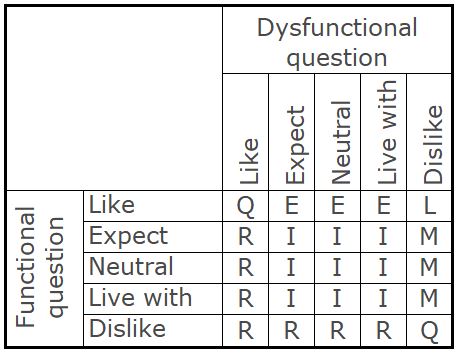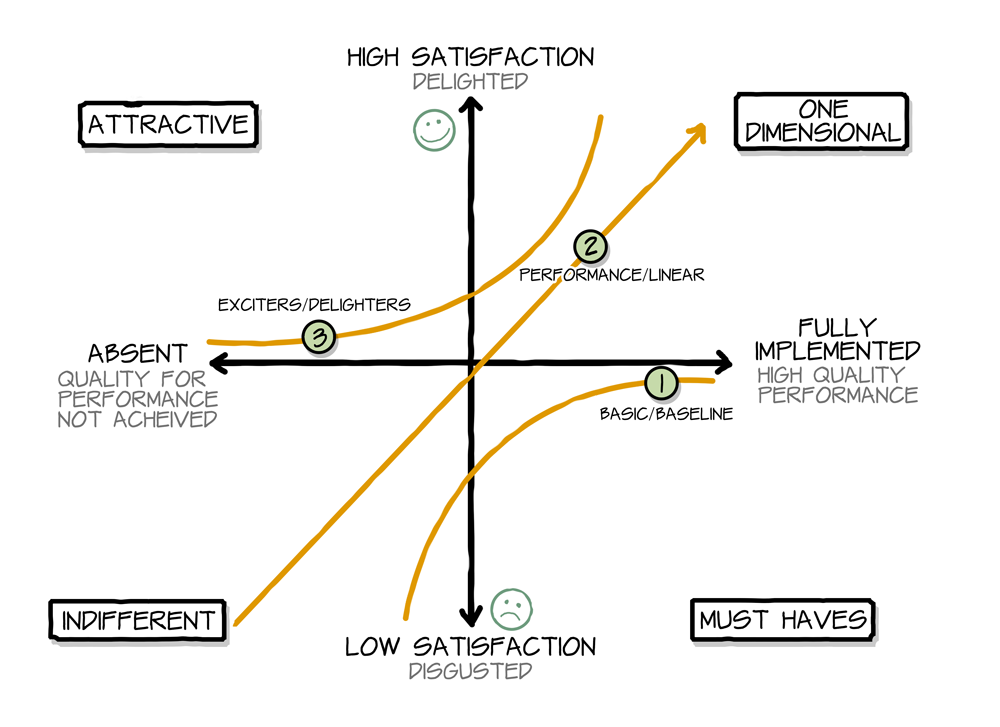Kano Model of Customer Satisfaction

The Kano Model of Customer Satisfaction was developed in the 1980’s by Professor Noriaki Kano of Tokyo University of Science. His model provides a simple ranking scheme that distinguishes between essential and differentiating attributes.
In Kano, we ask a series of questions in two different forms: functional and dysfunctional. For example, let’s say we are asking customers about a GPS navigation system for cars.
We first ask the functional form of the question:
- How would you feel if this car had a GPS navigation system?
We limit the responses to the following answers:
- I’d like it that way ✅
- I’d expect it to be that way
- I am neutral
- I could live with it that way
- I’d dislike it that way
For this example, let’s say that our fictional customers responded with “I like it that way.”
Next we ask the dysfunctional form of the question:
- How would you feel if this car did not have a GPS navigation system?
Like we did in the previous question, we limit the responses.
- I’d like it that way
- I’d expect it to be that way✅
- I am neutral
- I could live with it that way
- I’d dislike it that way
Our fictional customers can choose from any of the answers listed. However, the answer can often be, and usually is, different. For this example, let’s say that our fictional customers responded “I expected it to be that way” to the dysfunctional form of the question.
When we do this for an actual project, we can ask this list of opposing questions to multiple customer groups, that is, different sets of individuals who represent different functions of the customer organization. You might have a marketing group, an accounting group, a manufacturing group, and so on. For the purposes of understanding the model, however, let’s imagine that we ask just one question of just one customer group. After we compile our answer pair (the answers to the functional and dysfunctional form), we map it onto a grid, as Table 1 shows.

Table 1 – Kano Mapping
Note that, in our example, our fictional customers answered like to the functional question and expect to the dysfunctional question. When we map this pair to the grid, we can see that the intersection of those two attributes is an E, as the yellow highlighted square indicates. Let’s examine what that means for our prioritized backlog.
- E = Exciters/Delighters. These are features that the customer did not expect and that truly differentiate a product from its competitors. They are difficult to identify, especially initially, because it can be difficult to come up with questions that elicit exciting features. For this reason, exciters tend to emerge and rise in priority as the project progresses and customer feedback begins.
- Customers receive great satisfaction from these features and are willing to pay a price premium to have them. For example, the iPod from Apple delighted customers with its intuitive ability to turn content to match the orientation of the screen. The absence of that feature would not have decreased satisfaction, however, because the customer wouldn’t have known to expect it.
- In our example, having GPS navigation would be an exciting feature. Exploring this feature, at least to the point of receiving customer feedback, should be a relatively high priority.
- B = Baseline/Mandator. These features must be in the product. They are the must-have, high-priority features.
- No matter how well these basic attributes are executed, the customer will remain neutral towards the product. A word processor, for example, must have “create document” and “save document” functions. They are the price of entry.
- If we had asked our customer group about seat belts, most people would answer that they expect a new car to come with seat belts and that they dislike it when it doesn’t. If we mapped those two answers on the grid, we would find that seat belts are a baseline (B), must-have feature.
- L = Linear/Performance. Also known as performance requirements, linear features correlate directly to customer satisfaction. They fall just below baseline features in priority but must be balanced against their cost.
- Increased functionality or quality of execution increases customer satisfaction. Decreased functionality decreases satisfaction.
- Product price is often related to these attributes.
- I = Indifferent. These features are least important to the customer and, as such, should be least important to the product. They will likely return little or no business value.
Table 1 also shows Q and R.
- Q: Questionable – The question is probably incorrect or the answer is suspect.
- R: Reverse – the combination of answers does not compute. Take the GPS navigation system – if someone answers that they expect it to be there but that they also like it if it is not, it’s an R answer.
If an answer pair is rated Q or R, you should investigate your questions or the answer pair more deeply.
